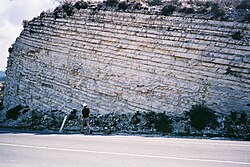Stratigraphy
Stratigraphy is a branch of geology which studies rock formations called strata (layers). It is important in the study of sedimentary and layered vocanic rocks.



Historical development
changeThe subject was established by Nicolaus Steno whose book De solido contained these principles:
- law of superposition: layers above were laid down after layers below.[1]
- principle of original horizontality: layers horizontal when they were laid down.[2]
- principle of lateral continuity in layers of sediment. Each stratum extended horizontally until some obstacle stopped it.[3]
William Smith first used stratigraphy for a practical purpose in the 1790s and early 19th century. Smith, nicknamed "Strata Smith", made the first geological map of England. He understood that fossils could be used identify the same strata in different places.
He took samples and mapped the positions of the strata, noted the vertical extent of the strata, and drew cross-sections and tables of what he saw. Smith amassed a huge collection of fossils in strata he had examined. His most significant finding was:
- The principle of faunal succession: sedimentary rock strata contain fossilized flora and fauna, and these fossils succeed each other vertically in a specific, reliable order which can be identified over wide horizontal distances.
There are many consequences of this idea. For geologists it means that when they find identical fossils in strata in different parts of the world, those strata were laid down at the same time. Also (this is a later realisation) the ecological conditions in which they were laid down would have been similar or identical in the different places.
Lithostratigraphy
changeLithostratigraphy deals with the physical rock type and how it changes from place to place. Changes in the rock (facies change) reflect changing environments of deposition. One of stratigraphy's basic concepts is codified in the law of superposition, which simply states that, in an undeformed stratigraphic sequence, the oldest strata occur at the base of the sequence.
Biostratigraphy
changeBiostratigraphy is based on fossil evidence in the rock layers. If strata from different places have the same fossil fauna and flora, they were laid down at the same time.
Biostratigraphy was based on William Smith's principle of faunal succession, which was one of the first and most powerful lines of evidence for evolution. It gives evidence of the formation (speciation) and extinction of species.
The geological timescale was developed during the 19th century based on the evidence of biostratigraphy and faunal succession. This timescale remained a relative scale until the development of radiometric dating, which gave it an absolute time framework.
Notes
change- ↑ transl: "... at the time when any given stratum was being formed, all the matter resting upon it was fluid, and, therefore, at the time when the lower stratum was being formed, none of the upper strata existed".
- ↑ "Strata either perpendicular to the horizon or inclined to the horizon were at one time parallel to the horizon".
- ↑ "Material forming any stratum were continuous over the surface of the Earth unless some other solid bodies stood in the way"